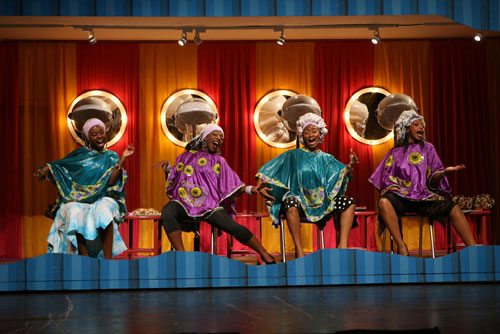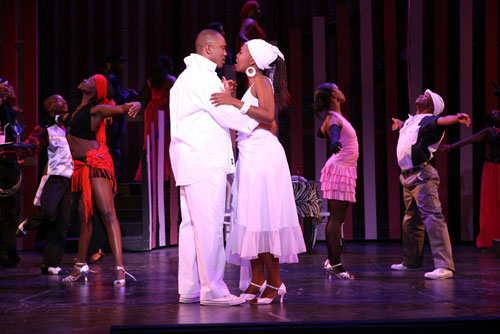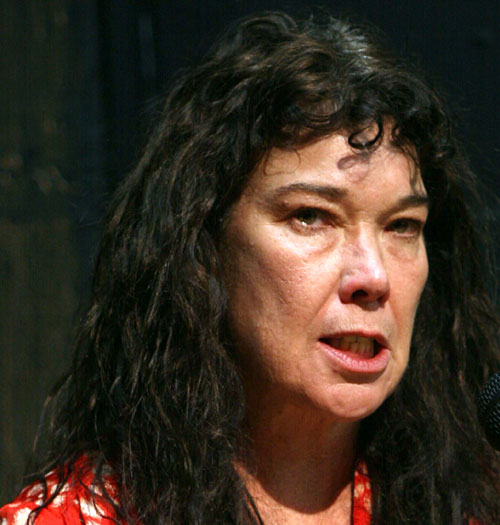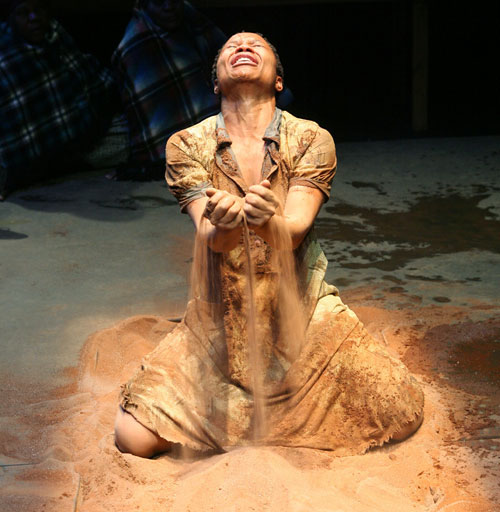|
It's freezing in South Africa. A rogue cold-front has swept in, breaking lowest-temperature records across the country, bringing snow to the beaches and icicles to the branches of Johannesburg's Jacaranda trees. We don't build our houses for cold weather here, so I'm writing this from under a mountain of pullovers, jackets, and woolly hats, trying to catch the faint traces of warmth wafting from the one-bar heater beside me. There's much to write about—the unseasonable cold has not slowed the arts of this city, and the theatres and music venues of 'Jozi' are kept busy with a variety of productions.
Broadway-style events seem to dominate the larger Johannesburg theatres at present—looking over the listings, there are productions of Hair, Grease, and The Lion King at our big-seater venues. Amongst these big-budget musicals is one with a South African flavour – Soweto Story, which recently finished a run at the Nelson Mandela Theatre.

The play is a reinterpretation of Shakespeare's great romantic tragedy, channeled through Laurents' West Side Story into a story of rival families and star-crossed lovers in Soweto. Using detailed sets and costuming, the production seeks to create a sense of Soweto's colour and action. With a cast of some exceptionally talented young stars, excellent choreography, and an African touch, Soweto Story will hopefully fill theatres worldwide when it goes on tour. But it did make me think about the reworking of earlier greats – why does reinterpretation work so well with some pieces, whilst with others it obscures the originality that should distinguish a work?

A few nights ago I made my way to the Market Theatre, one of our best-loved venues. Built on the site of the old Indian Fruit Market in downtown Johannesburg, the theatre has been in operation since the gold-field days of 1913. It's hosted the premieres of many of our greats, and is presently the home of Athol Fugard's new production, Victory.
I was there to see Molora, the latest offering from rising star Yael Farber. Farber has won international respect in a short space of time, both for her original plays and her adaptations of classic theatre. Her work has always kept a strong integrity of vision with regards to South Africa, and this new play was no different. Molora uses the underlying story from The Oresteia, the cycle of Greek tragedies written by Aeschylus at around 500 BC, as the groundwork for a play about the Truth and Reconciliation Commission (TRC). This was the body of leaders, plaintiffs, and former oppressors who sought, at a series of public hearings, to unearth and understand the injustices which took place in South Africa under the apartheid years. As a forum for expiation, mercy, and attempted redemption, the role of TRC cannot be overestimated. It was a time when the potential for bitterness and vengeance was at its zenith in South Africa, and the TRC became a beacon around which all the country's people could gather, to try to understand and forgive.
Farber's choice of The Oresteia was an excellent one—in its orbits of revenge and lingering feuds, woven around the dispossessed descendants of Agamemnon and his murderous wife Clytemnestra, there lies a powerful metaphor for South Africa's history. Molora was staged in the manner of a Greek tragedy—a trio of actors and the ever-present Chorus. The leads were played by Jabulile Tshabalala, Dorothy Ann Gould, and Sandile Matsheni, accomplished performers who were aware of the need to combine subtlety with melodrama. The Chorus was played by the Ngqoko Cultural Group, a group of men and women from the rural Transkei regions of South Africa. This was a striking reinterpretation– the Ngqoko Group work in a traditional Xhosa idiom, using percussion bows, friction drums, and the guttural 'split-tone' style of singing to create a truly unearthly sound.

Staged simply, with the audience encircling a square of bare boards, the set of Molora recalled the layout of the TRC proceedings. And as with the TRC, the play was not easy viewing. Farber has adapted the events of The Oresteia to highlight the brutal truths which emerged during the hearings—the state-sanctioned torture, the killings and disappearances. The ending, however, has been changed. The original tragedy completes its circle of revenge when Orestes, the exiled son of Agamemnon, returns to slay his mother and her new lover. Farber gives her Orestes the quality of mercy—knowing that vengeance is his, yet also understanding that in claiming it he will simply become part of a longer cycle of violence, he chooses to stay his sword. The word Molora means 'ash' in Xhosa. A symbol of death and loss, but also of the phoenix and the fertile earth – rebirth and redemption. This was excellent theatre.

There's no gain to be had by comparing Soweto Story and Molora, or the works on which they are based. The two pieces have wholly different styles and intentions, and I hope that both continue to great success as they leave their South African venues. But in speaking of the value of reinterpreting earlier works, the two productions provide a strong example of how this reworking can be an aid or a hindrance. Both plays take famed tragedies from the 'western' tradition, and seek to use their story in a South African context. The idea is excellent – the familiar form and narrative of the earlier piece allows the important elements of the new work to rise to the foreground. And so it was with Molora – the simple form and direct narrative of The Oresteia suited Yael Farber's adaptation perfectly, bringing out the harrowing South African edge. But with Soweto Story the sheer scale and bombast of the production, and its similarities with such a well-known Broadway spectacular, meant that it was not the strongly South African work it might have been. The music, sets, and names are authentic, but they are submerged in a style and story which dominates and diminishes them. It really is wonderful that we are producing large-scale musicals, that we've moved out of a period when virtually every production had a political-ideological edge. Soweto Story will hopefully be followed by many more, with less reliance on other works. I'll look forward to the day when I see a London theatre hosting an English reinterpretation of an original South African musical.
Images courtesy of Market Theatre
and Packed House Productions
|
